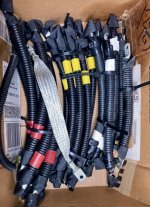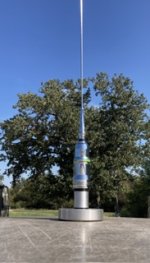I've been getting more active with the ham hobby so I have been paying attention to, and making more frequent use of the mobile setup and I've noticed a lot of interference on HF. I've got the source narrowed down to the vehicle itself, and its primarily a problem above 10mhz (and for the purposes of this post, we'll leave it at HF).
I have an Alinco DX-70 through a diplexer into a Little Tarheel II antenna. DC power is straight off a fused line from the battery through the firewall. DC ground is about a 10" wire bolted to a seat bracket. I did recently install a DC noise filter on the power lead, as well as experimenting with a BCB AM LPF that I think is set around 1.8mhz. I forget the brand, but I originally intended it for the house setup since I'm right between to AM transmitter sites. My superbly tuned frequency-spectrum-noise-hunting-noise-canceling ears are telling me there is a wide range improvement on the entire HF spectrum, but there is a pronounced increase in hash starting right at 10mhz and up. it makes that portion pretty much unusable when the vehicle is running.
The vehicle is a 2003 Dodge Ram 2500 with a 5.9 Cummins. The noise is present when the vehicle is running. The noise dramatically drops off with the antenna disconnected, though I need to repeat this test and check around a few spots on the band to confirm if there is still noise in the receive with nothing attached on the antenna port. I believe the truck is set up to cycle the grid heater at start up, as right when I fire it up, there is a cycling of increased RF noise that coincides with a dimming of the lights, like a heavy load is cycling on and off with the warmer weather is only does this for a few moments then stops.
This the first time for me narrowing down and dealing with an "external" noise problem that is very specifically above 10mhz.
Thoughts? Ideas? Critiques?
I have an Alinco DX-70 through a diplexer into a Little Tarheel II antenna. DC power is straight off a fused line from the battery through the firewall. DC ground is about a 10" wire bolted to a seat bracket. I did recently install a DC noise filter on the power lead, as well as experimenting with a BCB AM LPF that I think is set around 1.8mhz. I forget the brand, but I originally intended it for the house setup since I'm right between to AM transmitter sites. My superbly tuned frequency-spectrum-noise-hunting-noise-canceling ears are telling me there is a wide range improvement on the entire HF spectrum, but there is a pronounced increase in hash starting right at 10mhz and up. it makes that portion pretty much unusable when the vehicle is running.
The vehicle is a 2003 Dodge Ram 2500 with a 5.9 Cummins. The noise is present when the vehicle is running. The noise dramatically drops off with the antenna disconnected, though I need to repeat this test and check around a few spots on the band to confirm if there is still noise in the receive with nothing attached on the antenna port. I believe the truck is set up to cycle the grid heater at start up, as right when I fire it up, there is a cycling of increased RF noise that coincides with a dimming of the lights, like a heavy load is cycling on and off with the warmer weather is only does this for a few moments then stops.
This the first time for me narrowing down and dealing with an "external" noise problem that is very specifically above 10mhz.
Thoughts? Ideas? Critiques?



